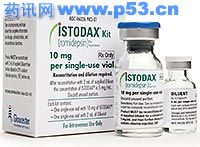制造商:
Celgene公司公司
药理分类:
抗肿瘤药(组蛋白去乙酰酶抑制剂)
活性成分(补):
Romidepsin 10mg/vial;为重建和稀释后静脉滴注密码;包含碘伏。
指示(补):
皮肤T细胞淋巴瘤(CTCL的)在谁已经接受了至少一个前全身治疗的患者。
药理作用:
组蛋白去乙酰化酶催化从组蛋白和非组蛋白乙酰化赖氨酸残基乙酰群去除,影响基因的表达。这种酶的抑制剂,如romidepsin,干扰与组蛋白和转录蛋白介导的活动。在体外,romidepsin已被证明造成乙酰化组蛋白的积累,并诱导肿瘤细胞株中的一些细胞周期停滞和细胞凋亡,但其确切作用机制治疗皮肤T细胞淋巴癌尚未阐明。
临床试验:
两个多中心,单臂临床研究被用来评估治疗皮肤T细胞淋巴癌的romidepsin疗效。患者治疗药物的研究,直到病情时在研究者和当地的监管权进展的推荐剂量。疾病的反应进行了评估目的使用复合终点,包括皮肤受累,淋巴结和内脏参与评估,以及不正常循环T细胞。每个研究的主要终点是总目标疾病的反应率(ORR),作为与确认完全缓解或部分缓解患者的比例确定。
研究1中后,至少有1前全身治疗失败96例确诊CTCL患者。在本研究ORR为34%(完全缓解+部分缓解6%28%)。中位缓解时间为15个月。
研究二包括71名初步诊断为CTCL的谁收到至少2之前,针对治疗皮肤或至少一个全身治疗的病人。在这项研究中,ORR为35%(完全缓解+部分缓解6%,30%)。中位缓解时间为11个月。
中位数时间为第一个反应是这两项研究的2个月。的平均时间为6个月完全缓解1和4的研究在研究2个月。
法律分类:
接收
成人:
≥18yrs:由静脉输注给超过4小时。 14mg/m2的日子1,8,和28天为一周期15;重复周期,每28天,继续为耐受性和有益的。可能中断,减少剂量10mg/m2,或停止对毒性(见文献)为基础。
儿童:
“18yrs:不推荐。
警告/注意事项:
纠正电解质不平衡(特别是钾,镁+ +),然后开始。监测心电图和电解质先天性长QT综合征,严重的心血管疾病。中度至重度肝损害。终末期肾病。央行监测的差距。妊娠(Cat.D;可能会对胎儿造成伤害)。哺乳母亲:不推荐。
互动(补):
可能会干扰荷尔蒙(雌激素)的避孕药具。注意与其他药物可能导致QT间期延长(监视器)。监视器葡萄牙/印度卢比与华法林。通过药物抑制P -糖蛋白和CYP3A4 Potentiated,避免随之而来的强CYP3A4的(例如,唑类抗真菌剂,蛋白酶抑制剂,克拉霉素,奈法唑酮)抑制剂。注意适度CYP3A4的抑制剂。 。拮抗强CYP3A4的诱导剂(如卡马西平,苯妥英,苯巴比妥,利福平,避免Concomittant圣约翰草:不推荐。
不良反应(补):
胃肠不适,疲劳,感染,厌食,贫血,血小板减少,心电图T波变化,中性粒细胞,淋巴细胞。
如何提供:
套件- 1(单次使用小瓶+稀释剂和用品)
最后更新:
2010年3月4日
Manufacturer:
Celgene Corp
Pharmacological Class:
Antineoplastic (histone deacetylase inhibitor)
Active Ingredient(s):
Romidepsin 10mg/vial; pwd for IV infusion after reconstitution and dilution; contains povidone.
Indication(s):
Cutaneous T-cell lymphoma (CTCL) in patients who have received at least one prior systemic therapy.
Pharmacology:
Histone deacetylases catalyze the removal of acetyl groups from acetylated lysine residues in histones and non-histone proteins, affecting the expression of genes. Inhibitors of this enzyme, such as romidepsin, interfere with activities mediated by histones and transcription proteins. In vitro, romidepsin has been shown to cause the accumulation of acetylated histones and to induce cell cycle arrest and apoptosis in some cancer cell lines, but its exact mechanism of action in treating CTCL has not been elucidated.
Clinical Trials:
Two multicenter, single-arm clinical studies were used to evaluate the efficacy of romidepsin in treating CTCL. Patients were treated with the study drug at the recommended dose until disease progression at the discretion of the investigator and local regulators. Objective disease response was evaluated using a composite endpoint that included assessments of skin involvement, lymph node and visceral involvement, and abnormal circulating T-cells. The primary endpoint for each study was overall objective disease response rate (ORR), defined as the proportion of patients with confirmed complete response or partial response.
Study 1 included 96 patients with confirmed CTCL after failure of at least 1 prior systemic therapy. The ORR in this study was 34% (complete response 6% + partial response 28%). Median duration of response was 15 months.
Study 2 included 71 patients with a primary diagnosis of CTCL who received at least 2 prior skin directed therapies or at least one systemic therapy. In this study, the ORR was 35% (complete response 6% + partial response 30%). Median duration of reponse was 11 months.
The median time to first response was 2 months in both studies. The median time to complete response was 6 months in Study 1 and 4 months in Study 2.
Legal Classification:
Rx
Adults:
≥18yrs: Give by IV infusion over 4hrs. 14mg/m2 on days 1, 8, and 15 of a 28-day cycle; repeat cycle every 28 days; continue as tolerated and as beneficial. May interrupt, reduce dose to 10mg/m2, or discontinue based on toxicities (see literature).
Children:
<18yrs: not recommended.
Warnings/Precautions:
Correct electrolyte imbalances (esp. K+, Mg++) before starting. Monitor ECG and electrolytes in congenital long QT syndrome, significant cardiovascular disease. Moderate to severe hepatic impairment. End-stage renal disease. Monitor CBC with differential. Pregnancy (Cat.D; may cause fetal harm). Nursing mothers: not recommended.
Interaction(s):
May interfere with hormonal (estrogen) contraceptives. Caution with other drugs that can cause QT prolongation (monitor). Monitor PT/INR with warfarin. Potentiated by drugs that inhibit P-glycoprotein and CYP3A4; avoid concomitant strong CYP3A4 inhibitors (eg, azole antifungals, protease inhibitors, clarithromycin, nefazodone). Caution with moderate CYP3A4 inhibitors. Antagonized by strong CYP3A4 inducers (eg, carbamazepine, phenytoin, phenobarbital, rifampin; avoid. Concomittant St. John’s Wort: not recommended.
Adverse Reaction(s):
GI upset, fatigue, infections, anorexia, anemia, thrombocytopenia, ECG T-wave changes, neutropenia, lymphopenia.
How Supplied:
Kit—1 (single-use vial + diluent and supplies)


